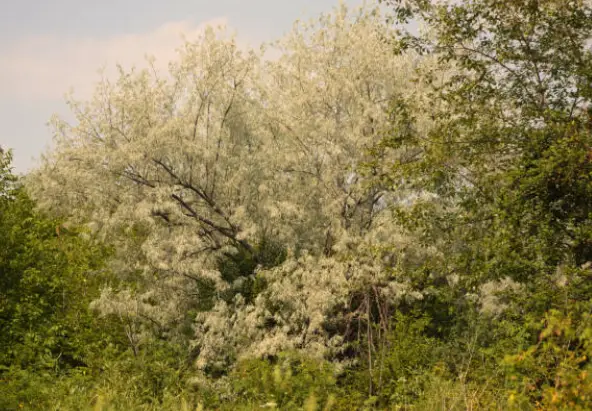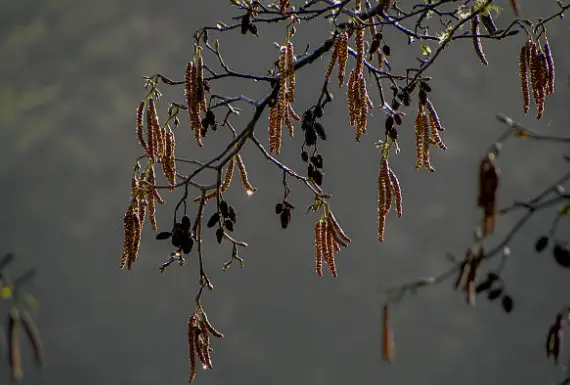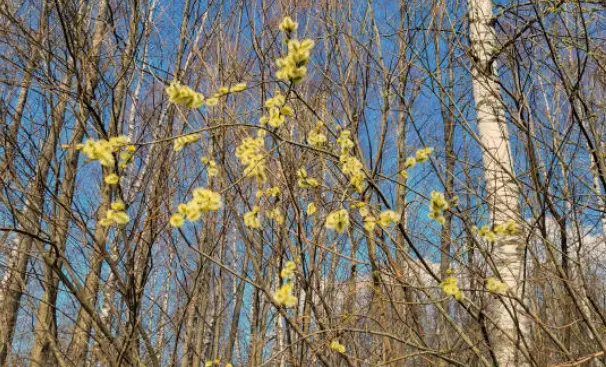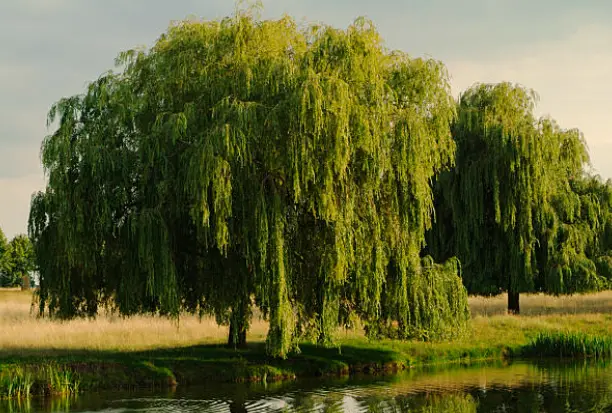Poets, artists, and lovers of the outdoors have long been enthralled by the willow family of deciduous trees and shrubs. These trees are widely appreciated for their beautiful, hanging limbs and vivid green foliage in parks, gardens, and beside streams worldwide. Beyond only being beautiful, willows are also extremely varied and adaptable plants, with many species having different environmental adaptations and functional uses.
So, going through this blog post, we will look into the traits, types, and applications of willow trees. This post will provide you with a wealth of knowledge to appreciate the wonder of willows, whether you are a gardener looking for the ideal willow for your landscape, a naturalist enthralled by their ecological significance, or just someone who appreciates the beauty and resilience of these remarkable plants.
Characteristics of Willow Trees
Willows are members of the Salix genus, which is found in portions of the Southern Hemisphere and the Northern Hemisphere and comprises more than 400 species. Due to their preference for moist soil, these trees and shrubs are usually found in wet areas like lakeshores, marshes, and riverbanks.
Willows are easily recognized by their thin, flexible branches, which frequently fall softly to the ground. Their distinct wood structure which is comparatively soft and malleable in comparison to other trees is the cause of this attribute.
Willow branches are renowned for their propensity to quickly form roots when buried in the ground or submerged in water; this characteristic adds to their hardiness and ease of spreading.
Willow trees usually have elongated, slender leaves that are positioned alternately on the branches. The sizes and shapes of their leaves can change greatly among species, from lance-like to oval or rectangular. A remarkable green-gray or silver-green color is another characteristic that many willows have, which gives them a unique and eye-catching appearance.
Willow Trees Species Around the World
There are more than 400 species of willows to discover, making their environment incredibly fascinating and varied. Let us examine some of the most well-known and common species of willow trees in more detail:
Weeping Willow (Salix babylonica)

Weeping Willow
The weeping willow, a breathtakingly beautiful tree with long, drooping branches that reach towards the ground, is maybe the most famous and identifiable type of willow. This species, which is native to China, has been farmed and brought to other regions of the world for decorative purposes. Weeping willows are frequently seen beside streams, in parks, and in gardens. Their graceful shape lends these areas a calming, enthralling quality.
White Willow (Salix alba)

Willow Trees Species
The white willow is a large and sturdy tree that can grow up to 25 meters tall. It is native to Europe and parts of Asia and is widely cultivated for its timber, which is used in various applications, including furniture, cricket bats, and charcoal production. The bark of the white willow is grayish-brown, while its leaves are lance-shaped and silvery-green in color.
Black Willow (Salix nigra)

The dark, wrinkled bark of the black willow, as its name implies, is what sets it apart from its thin, yellowish green branches and small leaves. This species, which is indigenous to North America, is frequently found around marshes, rivers, and streams. Because of its wide root system and capacity to stabilize riverbanks, this tree is beneficial for reducing erosion and restoring habitat.The dark, wrinkled bark of the black willow, as its name implies, is what sets it apart from its thin, yellowish-green branches and small leaves. This species, which is indigenous to North America, is frequently found around marshes, rivers, and streams. Because of its wide root system and capacity to prevent erosion, this tree is beneficial for restoring habitat.
Crack Willow (Salix fragilis)

The crack willow is a broad, spreading tree whose fragile branches are prone to breaking off or “cracking” in strong winds. This species is commonly grown despite its fragility because of its aesthetic appeal and capacity to swiftly develop and maintain crumbling banks. Native to Europe and Western Asia, crack willows have been brought to many other parts of the world.
PussyWillow (Salix discolor)

The Pussywillow, so named because of its unusual, fuzzy catkins that appear in the early spring, is a well-liked sign of the passing of the seasons. These delicate, fuzzy “pussies,” or catkins, are the flowering structures of the willow and are commonly seen in bouquets and floral arrangements. Native to North America, Pussywillows are small trees or shrubs that are frequently found near marshes and streams.
Versatile Uses of Willow Trees
Willows are fascinating not simply for their aesthetic appeal but also for their vast range of useful applications. These trees have been used historically for many different things, such as artisanal products, traditional remedies, and environmental conservation.
Medicinal Uses
The bark, leaves, and twigs of various willow species have been used for centuries in traditional medicine for their analgesic (pain-relieving) and anti-inflammatory properties. This is due to the presence of salicin, a natural compound that is chemically similar to aspirin. Willow bark extracts have been historically employed to treat conditions like headaches, fevers, and arthritis and continue to be studied for their potential therapeutic benefits.
Basket Weaving and Crafts
Willows are a great material for crafts like basket weaving because of their robust and flexible branches. For generations, woven willow has been used to create baskets, furniture, and decorative items. Different cultures and groups have created their own unique designs and methods of production. Willow weaving is still highly valued as an artisanal craft in many areas today, producing both useful and ornamental items.
Environmental Applications
Willows are important for environmental rehabilitation and protection. They are important for maintaining wetland ecosystems, preventing erosion, and stabilizing riverbanks due to their large root systems and capacity to flourish in damp conditions. Willows are also frequently utilized in phytoremediation, a technique in which contaminated soil or water is treated using plants to either remove or immobilize toxins.
Bioenergy and Biomass
Willows have drawn interest recently as a possible source of biomass and bioenergy. Rapidly expanding willow species can be grown as short-rotation coppice crops, in which the stems are removed for industrial purposes or as a renewable fuel source every few years. This sustainable method helps to preserve soil and sequester carbon, in addition to offering a supply of biomass.
Landscaping and Ornamental
Make use of Of course, landscaping and decorative gardening are two of the most common and cherished applications for willows. Willows provide a plethora of possibilities for embellishing outdoor settings with their graceful forms, vivid foliage, and different sizes and shapes. These trees are a gorgeous and adaptable option for both public and garden areas. Weeping willows, for example, offer peaceful and quiet settings, while shrub-like species work well as screens or hedges.
Cultivating and Caring for Willow Trees
In case you are feeling motivated to integrate the elegance and adaptability of willows into your personal garden or scenery, bear in mind these crucial factors:
Site Selection
Willows enjoy full sun to partial shade and grow best in moist, well-drained soil. Make sure the soil is not too dry or compacted and that the area gets enough moisture before choosing a planting location.
Planting and Propagation
Cuttings can be used for the simple and effective propagation of willows. Just take stem cuttings from an established willow tree, peel off some of the bark around the base, and plant the cuttings in soil that has been moistened. The cuttings will form roots and grow into new willow trees if given the right conditions, including moisture.
Pruning and Maintenance
Willow trees require regular pruning in order to maintain their shape and general health. Remove any crowded, diseased, or damaged branches during the late winter or early spring pruning. Because willows grow quickly, frequent pruning may be necessary to keep them in the proper shape.
Pest and Disease Management
Willows can be vulnerable to a number of pests and diseases, including willow leaf beetles, willow scab, and black canker, despite their general resistance. These problems can be prevented and managed with the use of routine monitoring and appropriate cultural practices, such as limiting watering and making sure there is adequate air circulation.
Honoring Willows’ Wonderfulness Willow trees are genuinely amazing plants that merit our respect and admiration because of their beautiful shapes, vivid foliage, many applications, and ecological value. These trees offer a multitude of chances for discovery and enjoyment, whether you are drawn to their ornamental beauty, inspired by their useful applications, or captivated by their historical and cultural significance.




